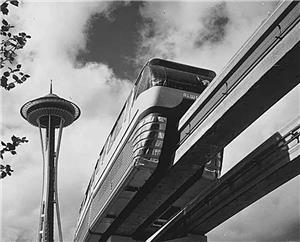On July 25, 1971, a brake failure on the red train of Seattle's Monorail leads to a crash against a steel girder at the end of the track at the Seattle Center. Twenty-six people are injured.
“HANG ON!” yelled the driver of the red train as the monorail neared the end of the line at the Seattle Center that warm Sunday night.
Witnesses waiting in the Seattle Center terminal were also startled. The train was not slowing as it pulled into its normal stop at the Center.
About 40 to 50 people were on the train as it made its last run of the day from downtown Seattle (near present-day Westlake Center) to the Seattle Center. At 9:54 p.m., the train smoothly negotiated the curve on the approach to the center. Numerous witnesses on the train said the train initially seemed to slow a bit, but then, inexplicably, seemed to speed up.
As the train approached the station without slowing down, some of the passengers realized or sensed something was wrong. “As we came in, some people seemed restless. A few screamed ... . I heard a lot of gasps and people started screaming before it happened,” said passenger Scott Carpenter (Seattle P-I).
“What the hell’s going on?” yelled the driver, Willis Kirk, 28. Then he shouted: “HANG ON!” (The Seattle Times).
Jesse Simson, who was standing near the terminal as the train approached, said “I saw it coming and I thought it was funny -- it didn’t slow down; it just kept going and wham!” (Seattle Post-Intelligencer).
The train slammed into a steel girder at the end of the track, placed there for the purpose of keeping any out-of-control train from running off the tracks and ramming into the terminal station at the Center. Witnesses both on the train and on the ground estimated that the train was traveling between 15 and 20 m.p.h. when it hit the girder.
“The girder cut into the front of the coach like an ax, caving in the roof,” reported The Seattle Times the following day. The glass front of the car shattered and the metal front of the car below the glass caved in to the first row of seats, knocking the first two rows of seats askew. The sides of the front car buckled from the force of the impact.
One woman in a passenger seat directly opposite the driver was reportedly thrown through the shattered glass front of the car upon impact. Another witness reported people “sticking out of the front” (of the train) after the crash. Some witnesses in and near the Center terminal ran to help people off the train; others simply stood nearby and watched. Twenty-six people were injured, 13 significantly enough to be hospitalized overnight. Two people were seriously injured, but there were no fatalities.
Despite his position in the front of the car, driver Willis Kirk sustained relatively few injuries other than face cuts and bruises. He declined to speak with reporters about the accident.
The day after the crash, a Seattle Post-Intelligencer article noted that officials investigating the crash were speculating that not only had the air brakes failed but the backup “fail safe” system, designed to automatically apply brakes in the event of an air brake failure, had also failed. Investigators later confirmed that it was in fact a brake failure that caused the crash.
The blue train was unaffected by the accident and was in operation the next day.
The Seattle Times reported that similar accidents had occurred in 1962 and 1963, but both of those accidents were minor and no injuries resulted.
The Monorail has since been involved in a few other mishaps, but the 1971 accident remains the most serious accident to date (2005) for the Seattle Monorail.

